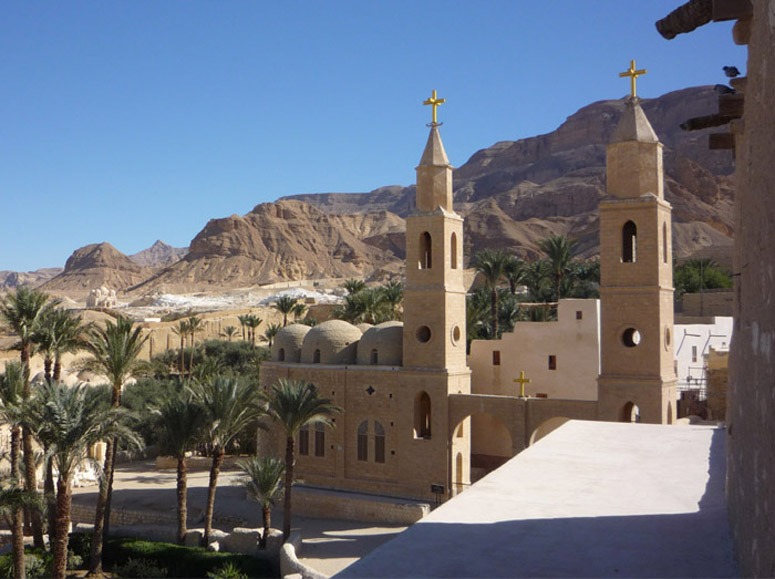Saint Anthony (c 251–356) is known as ‘the Father of All Monks’. Athanasius wrote his biography and it spread monasticism in Western Europe. He was not the ‘first monk’ but he was a Christian ascetic who went into the wilderness. The present monastery was built (c 356) on his burial site and near his retreat. Its fortified character was a response to Bedouin attacks. St Anthony gave his father’s money to the poor and ‘shut himself up in a remote cell upon a mountain’ so that ‘filled with inward peace, simplicity and goodness’ he ‘cultivated and pruned a little garden’. Presumably, the garden was his food supply and the wilderness was the subject of his contemplation. This may well be the origin of a Christian approach to gardens, seeing them primarily as functional places – not as symbolic or luxurious places. Cloister garths belong to a different tradition: they are symbolic; they probably did not have a ‘use’; they became places of luxury. See posts on Certose Cloister, Canterbury Cloister, Salisbury Cloister and a hypothesis concerning the origin of Christian monasticism. Islam does not have a monastic tradition, though there are Dervish brotherhoods, possibly because the Arabs had sufficient experience of living in deserts.
(Image courtesy Miami Love)


The garden in the spiritual literature is used both literally and allegorically. Anthony’s little garden may have been allegorical! [ http://www.escholarship.org/editions/view?docId=ft5b69p02d&chunk.id=d0e3390&toc.depth=1&toc.id=d0e3267&brand=eschol ]
Other symbolic uses of the word ‘garden’ in a theological context are:
(1) paradise (this is more often found in the Koran than the Bible)
(2) in the Song of Songs ‘4:12 “garden” – The garden refers to her vulva and vagina. When the lover says it is locked, he is saying it has never been entered; she is a virgin. Thus to describe his wife’s vulva as a garden is to say it is beautiful to behold, like flowered gardens of the East’ See http://www.marriage-vineyard.com/id88.html . A number of writers have also placed this interpretation on the Romance of the Rose.
St Bernard of Clairvaux gives a commentary on the Song of Songs in 86 Sermons.
[ http://www.pathsoflove.com/bernard/songofsongs/contents.html ]Origen’s commentary on the Song of Songs has been described as “the first great work of Christian mysticism.”
Perhaps theology [Song of Songs] and literature [Romance of the Rose] classes would be more popular if the texts you mention were studied!
Very interesting re St Bernard. The Cistercians were famed for their sensitivity to landscape and Fountains Abbey was subsequently integrated with the design of Studley Royal. St Bernard focussed attention on the Virgin Mary (http://en.wikipedia.org/wiki/Bernard_of_Clairvaux ) but as this search of his sermon on the Song of Songs shows, he seems not to have noticed the symbolism of gardens in the Song of Songs.
It would seem that Clairvaux was at least initially quite austere. Bernard seems not to have cultivated a garden either for food or contemplation when the monastery was founded. [ http://www.ewtn.com/library/MARY/Bernard2.htm ] It would also seem his acquaintance with gardens is from his youth as his family were of noble origin.
I am not sure whether the symbolism you speak of is the ‘milk’ rather than the ‘bread’ for Bernard?
The study of monasticism has been dominated by church historians and sadly neglected by the social scientists (psychologists, sociologists, economists, criminologists etc).
But on another point: St Anthony’s Monastery appears to be a wonderful example of how to design an environment for living in a hot arid climate: thick-walled buildings set in a shady grove of drought-tolerant plants.
At the risk of exposing myself as a miserable pedant I would like to point out that the Date Palm is not a drought-tolerant species. Just the opposite, their requirement in the Middle East for 150 litres of water per tree per day is double that of many other trees. They are planted ornamentally today mainly for cultural reasons, in St. Anthony’s time their presence would have been more closely aligned with aiding human survival in a harsh environment. They are also not very good at providing shade.
Thank you for the corrections. Why aren’t date palms being planted for dates? One of the earliest descriptions of Arab culture, by a Roman, records that they often lived amongst date palms – and it would appear that this is what is happening at St Anthony’s Monastery. I have not been there but it is quite possible that they are growing, or used to grow, vegetables beneath the palms, as was done in Mesopotamian gardens.
Date Palms are still being planted for dates, but they are only commercially viable in clearly defined districts. Availability of water and low humidity are essentials. Here in the UAE the plantations centre around the oasis towns of Al Ain and Liwa. The hundreds of thousands of Date Palms lining the streets and parks of the capital city, Abu Dhabi, are primarily ornamental, the high humidity rots the dates on the tree although they are still edible. They need a lot of water, a lot of maintenance, throw poor shade, are very messy and aggressively thorned, but despite this they are the mainstay of most public plantings because of the high cultural esteem in which this tree is held. The best and most expensive dates are apparently grown in Saudi Arabia.
It seems this question belongs to the study of the archaeology of food! [ http://apollo5.bournemouth.ac.uk/tag97/Eat_tonight.htm ] See Mary Harlow and Wendy Smith’s ‘Between Fasting and Feasting : The Historical and Archeobotanical Evidences for Monastic Diet – Egypt.(University of Birmingham)